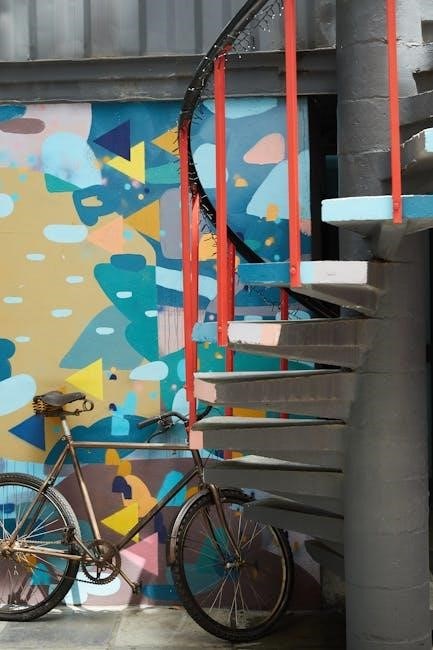
colour wheel pdf
The color wheel is a visual representation of color relationships, created by Isaac Newton. It organizes colors in a circle, showing primary, secondary, and tertiary hues. This tool helps artists and designers understand how colors interact, creating harmonious schemes and enhancing creativity in various fields like art, design, and fashion.

Definition and Purpose of the Color Wheel
The color wheel is a circular chart that visually represents the organization of colors and their relationships. It is divided into primary, secondary, and tertiary colors, demonstrating how they blend and contrast. The primary colors—red, yellow, and blue—form the base, while secondary colors like orange, green, and violet are created by mixing two primary colors. Tertiary colors are formed by combining primary and secondary colors, resulting in hues like yellow-green and blue-violet. The color wheel serves as a fundamental tool for artists, designers, and educators to understand color theory, enabling the creation of harmonious color schemes and informed design decisions. Its purpose is to simplify the complexity of color relationships, making it easier to identify complementary, analogous, and triadic color combinations. This visual guide is essential for anyone seeking to master color harmony and application in art, fashion, and design.

Importance of the Color Wheel in Design and Art
The color wheel is an indispensable tool in design and art, providing a structured way to understand and apply color relationships. It helps artists and designers create visually appealing compositions by identifying harmonious color schemes, such as complementary, analogous, and triadic combinations. By using the color wheel, creators can evoke specific emotions and moods, as warm and cool colors have distinct psychological impacts. It also aids in selecting colors that enhance brand identity in graphic design and marketing. The color wheel is equally valuable in education, teaching the fundamentals of color theory to students and professionals alike. Its versatility makes it a cornerstone in various creative fields, from painting and fashion to digital design and interior decorating. Ultimately, the color wheel bridges the gap between artistic expression and technical precision, ensuring effective communication through color.

Structure of the Color Wheel
The color wheel is organized in a circular format, beginning with primary colors (red, yellow, blue) and progressing to secondary colors (orange, green, violet). Tertiary colors are created by mixing primary and secondary hues, forming a comprehensive spectrum that aids in understanding color relationships and harmony.
Primary Colors: Red, Yellow, and Blue
Primary colors (red, yellow, and blue) are the foundation of the color wheel and cannot be created by mixing other colors. They are vibrant and pure, serving as the base for all other hues. Red symbolizes energy and passion, yellow represents optimism, and blue evokes calmness. These colors are essential in color theory, as they are used to create secondary and tertiary colors through mixing; Their unique properties make them indispensable in art, design, and branding, allowing artists to express emotions and ideas effectively. Understanding primary colors is crucial for mastering color relationships and harmonies in various creative fields.
Secondary Colors: Orange, Green, and Violet
Secondary colors (orange, green, and violet) are created by mixing two primary colors. Orange is formed by combining red and yellow, green by mixing blue and yellow, and violet by blending blue and red. These colors are vibrant and add depth to designs. Orange evokes energy and warmth, green symbolizes balance and harmony, while violet represents creativity and luxury. Secondary colors are crucial in color theory, as they expand the range of hues available for artistic expression. They are often used in color schemes like complementary, analogous, and triadic to create visually appealing combinations. Understanding secondary colors enhances the ability to design cohesive and impactful visual compositions in art, fashion, and digital design.
Tertiary Colors: Yellow-Green, Blue-Green, Blue-Violet, Red-Violet, Red-Orange, and Yellow-Orange
Tertiary colors are created by mixing a primary color with a secondary color, resulting in six distinct hues: yellow-green, blue-green, blue-violet, red-violet, red-orange, and yellow-orange. These colors are more complex and nuanced than primary or secondary colors. Yellow-green combines yellow and green, offering a vibrant, energetic feel, while blue-green blends blue and green for a calming effect; Blue-violet mixes blue and violet, creating a rich, dramatic tone. Red-violet combines red and violet, evoking luxury and creativity. Red-orange blends red and orange for warmth and vitality, and yellow-orange mixes yellow and orange for brightness and optimism. Tertiary colors add depth and variety to designs, enabling artists and designers to craft intricate and emotionally resonant color schemes. They are essential for advancing color theory and enhancing visual compositions in art, fashion, and design.

Color Theory Basics
Color theory is the study of how colors interact and influence each other. It explores fundamental concepts like hue, saturation, and value, and the psychological impact of warm and cool colors, aiding in creating harmonious designs.

Understanding Hue, Saturation, and Value
In color theory, three fundamental properties define a color: hue, saturation, and value. Hue refers to the actual color itself, such as red, blue, or green. Saturation describes the intensity or purity of the hue, ranging from bright, vivid colors to muted, grayish tones. Value indicates the lightness or darkness of a color, with white being the highest value and black the lowest.
Adjusting these properties allows for endless color variations. For instance, increasing saturation intensifies the color, while decreasing it makes it softer. Changing the value modifies the color’s brightness, creating tints (lighter shades) or shades (darker tones). Understanding these elements is crucial for creating contrast, balance, and harmony in designs and artworks. They are also essential for mastering color mixing and matching in various artistic and design applications.
Warm and Cool Colors: Psychological Impact
Warm colors, such as red, orange, and yellow, are often associated with warmth, energy, and excitement. They evoke feelings of comfort, vitality, and even urgency, making them ideal for stimulating environments. These colors advance visually, creating a sense of movement and activity. In contrast, cool colors, like blue, green, and purple, are linked to calmness, serenity, and tranquility. They have a soothing effect, often used in spaces meant for relaxation or focus. The psychological impact of these color groups is rooted in their emotional and cultural associations, influencing how they are used in art, design, and even branding to evoke specific moods or reactions. Understanding this distinction helps in making informed decisions about color choices for various applications, ensuring the desired emotional response is achieved. This contrast between warm and cool colors is a cornerstone of effective color theory and design strategies.
Color Harmony: Complementary, Analogous, and Triadic Schemes

Color harmony refers to the way colors work together to create visually appealing combinations. The complementary scheme pairs colors opposite each other on the color wheel, like blue and orange, producing high contrast and visual energy. The analogous scheme uses colors adjacent to each other, such as blue, green, and yellow-green, creating a smooth, cohesive look. In contrast, the triadic scheme selects colors forming a triangle on the wheel, such as red, yellow, and blue, offering a vibrant and balanced palette. These schemes are fundamental in art and design, helping creators evoke specific moods or emphasize elements in their work. By understanding these principles, artists and designers can craft harmonious color combinations that enhance their projects’ aesthetic and emotional impact. Each scheme provides a unique way to explore and utilize the color wheel effectively.

Advanced Concepts in Color Theory
This section explores advanced color theory concepts, including tints, tones, and shades, as well as monochromatic and split-complementary schemes. Neutral colors add depth and balance to designs.
Tints, Tones, and Shades: Modifying Colors
Tints, tones, and shades are essential for modifying colors to achieve desired effects. A tint is created by adding white to a base color, making it lighter and softer. This technique is often used in design to create subtle, calming effects. On the other hand, a shade is made by adding black, which darkens the color and adds depth. Shades are commonly used to create dramatic contrasts in art and design. A tone is created by adding gray, which balances the color and reduces its intensity. Tones are useful for creating nuanced and sophisticated color palettes. Neutral colors like black, white, and gray play a key role in these modifications. Understanding tints, tones, and shades is crucial for mastering color harmony and balance in various design applications, including digital design and branding.
Monochromatic and Split-Complementary Color Schemes
A monochromatic color scheme uses different tints, tones, and shades of a single base color. This creates a cohesive and harmonious look, often used in minimalist designs to evoke simplicity and elegance. By varying the lightness and saturation of one color, designers can achieve visual interest without the complexity of multiple hues. On the other hand, a split-complementary scheme expands on the complementary approach by selecting a base color and pairing it with the two colors adjacent to its complement. This method adds variety while maintaining balance, making it ideal for creating dynamic yet harmonious designs. Both schemes are versatile and can be adapted to various artistic and design projects, offering unique ways to explore color theory principles effectively.
The Role of Neutral Colors in Design
Neutral colors, such as black, white, gray, beige, and taupe, play a crucial role in design by providing balance and stability. They do not compete with other hues, allowing them to serve as a backdrop for more vibrant colors. Neutrals can enhance readability in typography, create contrast, and add sophistication to compositions. For instance, gray is often used to soften the intensity of bright colors while maintaining a modern aesthetic. Additionally, neutral tones can act as a bridge between warm and cool colors, unifying diverse elements in a design. Their versatility makes them indispensable in both traditional and digital art, enabling designers to experiment with color schemes while ensuring visual harmony. By incorporating neutrals, artists can achieve a polished and professional look, making them a fundamental component of effective design strategies.

Practical Applications of the Color Wheel
The color wheel is a versatile tool with wide-ranging applications in art, design, fashion, and branding. It helps create harmonious color schemes, enhances visual appeal, and guides effective color combinations, making it essential for professionals and enthusiasts alike.
Using the Color Wheel in Art and Painting
The color wheel is an indispensable tool for artists, providing a structured approach to understanding and mixing colors. It helps painters create harmonious color schemes by identifying complementary, analogous, and triadic relationships. Artists use the color wheel to mix primary colors (red, yellow, blue) into secondary hues (orange, green, violet) and explore tertiary shades. This visual guide aids in selecting contrasting colors to enhance compositions and evoke emotional responses. For instance, complementary colors placed side by side intensify their vibrancy, while analogous colors create smooth transitions. The color wheel also assists in achieving balance by distinguishing warm (red, orange, yellow) and cool colors (blue, green, violet). By studying the color wheel, artists can experiment with tints, tones, and shades to add depth and complexity to their work, ensuring visually appealing and professional results.
Application in Fashion and Interior Design
The color wheel is a vital tool in fashion and interior design, enabling professionals to create cohesive and visually appealing collections and spaces. In fashion, designers use the color wheel to select harmonious color combinations for fabrics and accessories. Complementary colors can make a bold statement, while analogous colors ensure a smooth transition between shades. Interior designers leverage the color wheel to choose wall colors, furniture, and decor that reflect a desired mood or style. For example, warm colors like orange and red can create a cozy atmosphere, while cool tones such as blue and green promote calmness. By understanding color harmony and contrast, designers can craft spaces and outfits that are both functional and aesthetically pleasing, ensuring a lasting impression on clients and consumers alike.

Utilizing the Color Wheel in Digital Design and Branding
The color wheel is an essential tool in digital design and branding, helping creators develop visually appealing and cohesive color schemes. Designers use it to select complementary, analogous, or triadic colors that enhance the visual appeal of websites, apps, and brand materials. Tools like Adobe Color Wheel simplify the process of generating harmonious palettes. In branding, the color wheel aids in creating a consistent identity, ensuring colors align with the brand’s message. For example, complementary colors can make text stand out, while analogous colors create a seamless gradient effect. The color wheel also supports accessibility by helping designers ensure proper contrast for readability; Its versatility makes it indispensable in both traditional and digital creative processes, enabling professionals to craft compelling visual experiences that resonate with audiences.
The color wheel remains a timeless and versatile tool for understanding color relationships, offering endless creativity in art, design, and education. Its principles are universally applicable, making it an essential resource for all.
The Versatility and Timeless Relevance of the Color Wheel
The color wheel is a universally applicable tool, essential for artists, designers, and educators. Its circular structure visually represents color relationships, simplifying the understanding of harmony, contrast, and mixing. Beyond art, it influences fashion, interior design, and branding, helping create cohesive visual identities. The color wheel also adapts to modern digital tools, such as Adobe’s Color Wheel, which enhances palette creation. Its principles, like complementary and analogous schemes, remain foundational in design. Additionally, it teaches the psychological impact of warm and cool tones, guiding emotional resonance in visuals. The color wheel evolves with technology yet retains its timeless relevance, proving indispensable in creative and educational contexts. Its versatility ensures it remains a cornerstone of color theory, inspiring innovation and learning across generations.